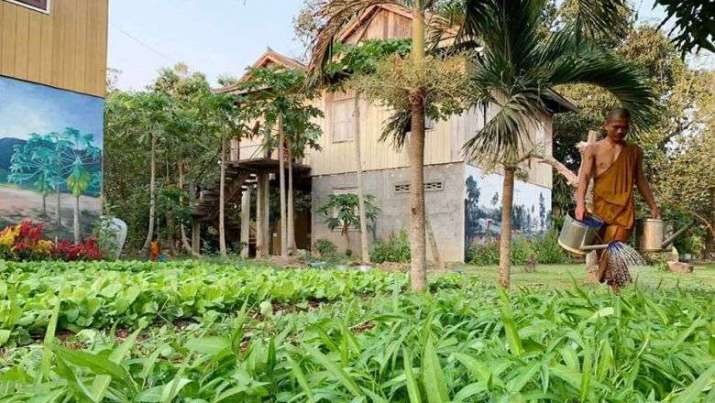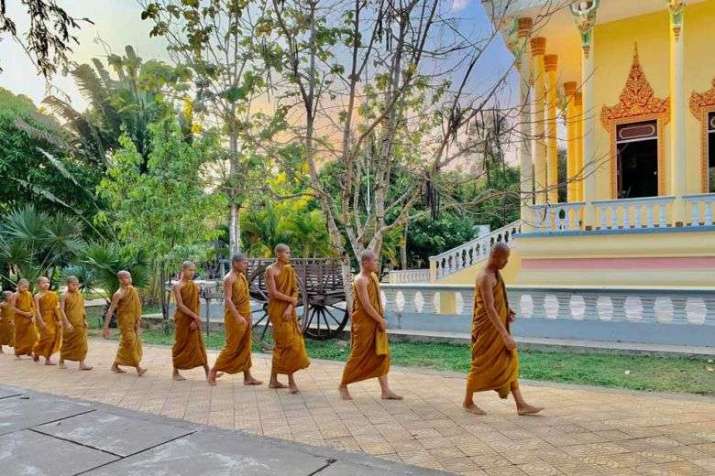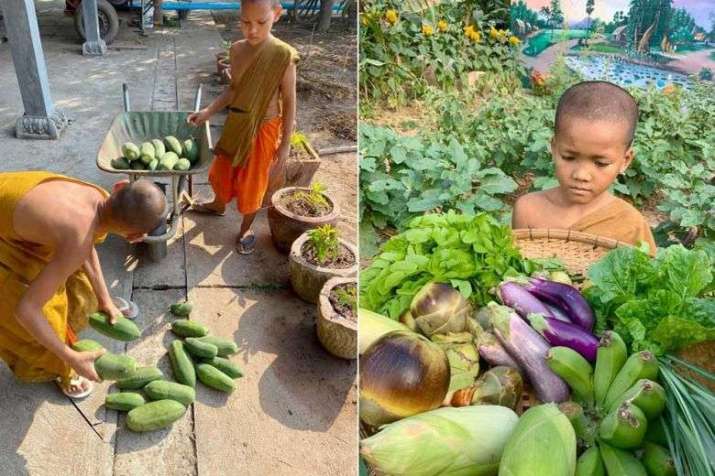NEWS
Sustainable Living in Cambodia: Buddhist Monks Farm Organic Produce
 Serei Sakor Daun Sdoeung Pagoda was named one of the best Buddhist centers out of 500 pagodas in Prey Veng Province. From phnompenhpost.com
Serei Sakor Daun Sdoeung Pagoda was named one of the best Buddhist centers out of 500 pagodas in Prey Veng Province. From phnompenhpost.comAs the need for more sustainable lifestyles grows increasing apparent, many Buddhist monks in Cambodia have redesigned their temples with garden spaces to enable the resident monastics to grow their own food.
Serei Sakor Daun Sdoeung Pagoda, located in Senareach Udom commune’s Snay Proem Village in Preah Sdach District, has designated a green space in which the resident monks grow a variety of rice, fruits, and vegetables, including lettuce, morning glory, spinach, Chinese kale, eggplants, tomatoes, corn, lemongrass, pumpkins, fragrant coconuts, water lilies, bananas, jackfruit, mangos, rose-apples, and papayas.
Initiated by the pagoda’s chief monk, Ven. Im Teang, some 10 years ago, the monks have since planted more than 3,000 trees on the surrounding land, as well as following other eco-friendly routines, such as strictly avoiding using plastic bags.
“I value spiritual and physical well-being and I believe that growing fruits and vegetables can contribute to both aspects of life. Growing organic vegetables helps monks and nearby villagers to be active through physical exercise as they sweat while working the land,” said Ven. Teang. “The pagoda doesn’t have to spend money to buy vegetable and risk consuming unhealthy foods.” (The Phnom Penh Post)
“We value our [own] life and we should not hurt others. Even trees are living things and we should not harm trees or nature because they’re living things just like us. I love trees and plants,” Ven. Teang explained. “If we have to fell one tree, we should replant two. Trees provide a green canopy to the Earth and other living things. They protect the Earth from global warming.” (The Phnom Penh Post)
 The monks have planted more than 3,000 trees and grow rice and vegetables. From phnompenhpost.com
The monks have planted more than 3,000 trees and grow rice and vegetables. From phnompenhpost.comConcerned about sustainability for health, the economy, and the environment, the monks use only natural fertilizers in their agriculture.
“I think that growing organic vegetables is not difficult. The technique goes back to the early days of our ancestors,” said Ven. Teang. “Growing and eating what you plant is good for [one’s] health. When you’re healthy, you can study and work effectively. It is not for no reason that people say ‘you are what you eat.’” (The Phnom Penh Post)
Serei Sakor Daun Sdoeung Pagoda helps the local villagers to grow organic food, sharing rice seedlings with them when the rainy season starts. It also offers its stocks of rice and vegetables to needy people.
“We have more vegetables and fruits than we need for our daily consumption. Our priority is to reserve them for nearby villagers. People who come from far away can also get food from the pagoda if we still have it in stock,” said Ven. Teang. (The Phnom Penh Post)
Built in 1874, Serei Sakor Daun Sdoeung Pagoda was almost destroyed during the Khmer Rouge period (1975–79). After the fall of the brutal regime, the monks and villagers began working together to rebuild the site. Now the pagoda is one of the most esteemed Buddhist centers out of 500 pagodas in Prey Veng Province, and is renowned as the greenest Buddhist temple in Cambodia.
 The monks cultivate lettuce, morning glory, spinach, Chinese kale, eggplant, and more. From phnompenhpost.com
The monks cultivate lettuce, morning glory, spinach, Chinese kale, eggplant, and more. From phnompenhpost.comAccording to The Phnom Penh Post, as of 2018 Cambodia had 4,932 pagodas, including 563 ancient temples. There are 68,654 monks mostly practicing Theravada Buddhism, who rely on donations and alms collected each day for their sustenance because the monks dedicate their lives to spiritual development. However, people praise Serei Sakor Daun Sdoeung Pagoda’s agricultural practice as a good example of self-reliant and sustainable living.
“What a great inspiration for all . . . sustainable green living. I must visit when I visit Cambodia,” commented Srey Thon, a follower of The Phnom Penh Post’s Facebook page.
See more
Pagoda shows the way to sustainable green living (The Phnom Penh Post)
The Phnom Penh Post Facebook
Related news from Buddhistdoor Global
Buddhist Monks in Wuhan Stir Up Social Media Storm with Offer to Share Vegetable Crop
Green Himalayas: Ladakh Launches Ambitious Climate Change Project
Former Bhutanese Education Minister Makes the Case for “Green Schools”
New Study Measure Impact of Chinese Buddhists with Vegetarian Diets on Greenhouse Gas Emissions
Related features from Buddhistdoor Global
Planetary Healing: Buddhism and World Ecology
Buddhist Perspectives on Sustainable Economic Development
My Grandmother’s Greenhouse and Other Portals to Wonder
Buddhism and Sustainability: A Conversation with Green Monday Founder David Yeung














